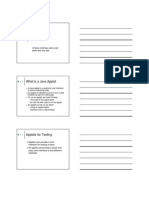Download Java for OS X 2017-001 Java for macOS 2017-001 installs the legacy Java 6 runtime for macOS 10.13 High Sierra, macOS 10.12 Sierra, macOS 10.11 El Capitan, macOS 10.10 Yosemite, macOS 10.9 Mavericks, macOS 10.8 Mountain Lion, and macOS 10.7 Lion. Download the Java Cryptographic Extension (JCE) for the currently supported version of Java from the Oracle site. Read the installation instructions that are included with the download. Copy the JCE jars to the java/lib/security directory where PDI is installed on the Linux client machine.
Java is a computer programming language that is concurrent, class-based and object-oriented. It was originally developed by James Gosling at Sun Microsystems. Java applications are compiled to bytecode (class file) that can run on any Java virtual machine (JVM) regardless of computer architecture.
Java is currently owned by the Oracle Corporation which acquired Sun Microsystems in 2010. Following tutorial will show you how to setup and configure Java 1.7 on Windows so you can develop and run Java code.
Check following posts if you are looking to download and install JDK 1.5, JDK 1.6, JDK 1.8, JDK 1.9 or JDK 1.10.
Java can be obtained from the Oracle Java download page. There are a number of different Java packages available, for this tutorial we will be installing Java Standard Edition (SE) on Windows.
In order to be able to compile Java code, we need the Java Development Kit (JDK) package that comes with a Java compiler. The JDK package also comes with a Java runtime environment (JRE) that is needed to run compiled Java code.
As we are installing an older Java version, you need to scroll all the way down to the bottom of the Oracle Java download page and click on the Download button in the Java Archive section. Then look for the Java SE 7 link and after clicking on it, select the correct operating system under Java SE Development Kit 7u80.
Here is the direct link to download the jdk 1.7.0_80 installer for Windows 32 or 64 bit.
Accept the License Agreement and pick the correct download for your operating system. In this example, we will use the Windows 64 bit version.
Sign in using your Oracle account (or create a new one) and the download should start. Once the download is complete, locate the jdk-7u80-windows-x64.exe file and double-click to run the installer.
Click Next and on the following screen optionally change the installation location by clicking on the Change... button. In this example the install location was changed to 'C:Javajdk1.7.0_80'. From now on we will refer to this directory as: [java_install_dir].
Next, the installer will present the installation location of the public JRE. We will skip this part of the installer as the JDK installed in the previous step comes with a private JRE that can run developed code. Just press Cancel and confirm by clicking Yes in the popup window.
Click Next and then Close to finish installing Java.

In order for Java applications to be able to run we need to setup a 'JAVA_HOME' environment variable that will point to the Java installation directory. In addition, if we want to run Java commands from a command prompt we need to setup the 'PATH' environment variable to contain the Java bin directory.
Java 1.7 Download Mac
When using Windows the above parameters can be configured on the Environment Variables panel. Click on the Windows Start button and enter “env” without quotes as shown below.
Environment variables can be set at account level or at system level. For this example click on Edit environment variables for your account and following panel should appear.

Click on the New button and enter “JAVA_HOME” as variable name and the [java_install_dir] as variable value. In this tutorial the installation directory is 'C:Javajdk1.7.0_80'. Click OK to to save.
Click on the New button and enter “PATH” as variable name and “%JAVA_HOME%bin” as variable value. Click OK to save.
Note that in case a 'PATH' variable is already present you can add “;%JAVA_HOME%bin” at the end of the variable value.
The result should be as shown below. Click OK to close the environment variables panel.
In order to test the above configuration, open a command prompt by clicking on the Windows Start button and typing “cmd” followed by pressing ENTER. A new command prompt should open in which the following command can be entered to verify the installed Java version:
The result should be as shown below.
This concludes the setting up and configuring JDK 1.7 on Windows.
If you found this post helpful or have any questions or remarks, please leave a comment.
LineUp is part of Caleydo and runs on Windows, Mac OS X, and Linux. We regularly test on Windows 7, Ubuntu/Kubuntu of the latest versions and Mac OS X.
Release Notes
TODO
Windows
Installation Checklist
- LineUp is tested with Windows 7 and Windows 8. We can not guarantee that LineUp works with earlier Windows versions.
- Check the System Requirements
- Install the latest Java. LineUp requires Oracle Java 7 (>= Java 7 Version 40) on Windows. To download Java, go here.
- Check your Java installation by opening a command prompt (run
cmd) and typejava -version. A correct installation should output something similar to this: - Install LineUp using the 64 bit installer (only on 64-bit systems), or download and extract the ZIP packages.
- Run LineUp from your launch menu (if installed) or execute
LineUp.exein the LineUp folder if using the ZIP packages. - On first start LineUp requires an internet connection to download pathways (about 80 MB) and sample projects (variable).
Windows Downloads
Mac OS X
Installation Checklist
- Check that you are running either Mac OS X Lion (10.7), Mac OS X Mountain Lion (10.8) or Mac OS X Mavericks (10.9). Older versions are not compatible with LineUp.
- Check the System Requirements
- Install the latest Java. LineUp requires Oracle Java 7 (>= Java 7 Version 40). You have to manually install the Java 7 JDK (NOT the JRE!).
- Check the installed Java version by opening a terminal window and running
java -version. A correct installation should output something similar to this: - Download and extract the LineUp ZIP file.
- Run LineUp by double-clicking the icon of the application extracted from the ZIP file. You may also drag the application into your 'Applications' folder.
- On first start LineUp requires an internet connection to download pathways (about 80 MB) and sample projects (variable).
Mac OS X Download
Linux
Installation Checklist
- Check the System Requirements
- Install the latest Java 7 (>= Open JDK 7 Version 25)
- Check your Java installation by running
java -version. A correct installation should output something similar to this: - Choose either 64-bit Debian package (for Ubuntu, Debian and other Debian-based distributions) and install it running: Or download and extract the tar ball:
- Run LineUp either from your launcher (if you used the debian package) or from inside the LineUp folder.
- On first start LineUp requires an internet connection to download pathways (about 80 MB) and sample projects (variable).
Linux Downloads
System Requirements
Memory

LineUp requires at least 2GB of RAM for the 64-bit versions and 1GB of RAM for the 32-bit version. For working with large projects we recommend at least 4GB.
Java 1.6.0 Free Download
Screen Resolution
LineUp can be run with a minimum screen resolution of 1280x1024, however, a higher resolution is recommended.
Graphics Cards
LineUp uses high-end computer graphics. While it works on a wide range of graphics cards and systems, dedicated graphics cards by NVidia or AMD are strongly recommended (for example, a graphics card better of the NVidia Geforce 8 series or better should be fine). Also make sure that you have the latest drivers installed. Download NVidia or AMD drivers.
Source Code
Caledyo 3 is licensed under the new BSD License. You can get access to the source code at GitHub.
Caledyo is open source software under the new BSD license. You may download and redistribute the software. Caleydo comes without any warranty; without even the implied warranty of merchantability or fitness for a particular purpose.
